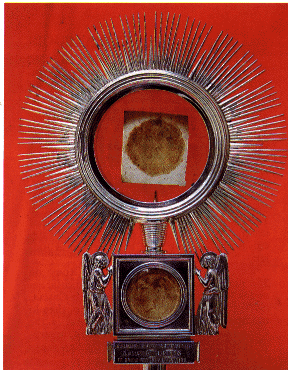In the year 1330, a priest in Siena who had lost all respect and belief in the Eucharist was asked to bring Holy Communion to a sick man in his town. He complied with this request reluctantly and placed the Consecrated Host unceremoniously between the pages of his breviary instead of following the correct procedure of placing it in a pix (pyx) and carrying it close to his heart. When he arrived at the sick man’s house and opened the breviary to give him Communion, he found that the Host was bleeding and there were round stains of blood on the two pages of the breviary between which it had been placed. The priest panicked and ran to the Augustinian monastery in Siena to confess this incident to Blessed Simon Fidati, known by all to be a holy man. Fr. Fidati granted pardon to the priest who was truly penitent. Blessed Fidati then took the two pages for safe-keeping and placed one in a tabernacle in Perugia, and the other he bought to the Augustinian Monastery of Cascia in Italy and placed it in a reliquary. The pages were preserved and numerous tests were performed confirming that it was indeed human blood.
To this day, the stains of the Precious Blood can be seen on the pages of the breviary which are preserved in the lower chapel of the Basilica of St. Rita in Cascia, Italy. Over the centuries, the relic of the Eucharistic Miracle has been venerated by faithful. Many people have observed in those blood stained pages, the image of a suffering human face. The miraculous event is particularly commemorated each year on the Feast of Corpus Christi, when the Relic is borne solemnly in procession.

“For my flesh is real food and my blood is real drink. He who eats my flesh and drinks my blood lives in me and I live in him.” John 6: 55-56
The Eucharist is the real Body and Blood of our Lord Jesus Christ. During the celebration of the Holy Mass, the bread and wine become the Body and Blood of Christ. The substance of the blood and wine is changed by the Holy Spirit into the substance of the Body and Blood of Jesus Christ even though the appearance remains that of bread and wine. This great mystery is known as transubstantiation. The body, blood, soul and divinity of Jesus Christ is present in every fragment of the consecrated Host and in every single drop of the Precious Blood. By his Real Presence in the Eucharist Christ fulfills his promise to be with us “always, until the end of the age” (Mt 28:20).
The Real Presence of our Lord in the Eucharist is a sign of Jesus’ love that He left for us so that we may receive Him as often as possible.
To be able to do so one must:
- Be baptized in the Catholic Church and be in communion with the teachings of the Holy Father and the Magisterium of the Church.
- Be in a state of grace, and therefore, confess all mortal sins; one must also receive the Sacrament of Reconciliation (Penance) at least once and year and when in danger of imminent death.
- Abstain from food and drink (except water) one hour before receiving communion. This does not apply to the sick.
- Attend Mass on Sundays and on all Holy Days of Obligation.
The Body and Blood of Christ present under the appearances of bread and wine are treated with the greatest reverence both during and after the celebration of the Eucharist. The Body of Christ under the appearance of bread that is kept or “reserved” in the Tabernacle after the Mass is commonly referred to as the “Blessed Sacrament“. That is why we need to genuflect when we are in front of the Tabernacle. It is our Lord Himself who is present in the Blessed Sacrament and we need to bow down and show him utmost reverence and adoration.








Recent Comments